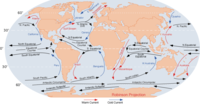
Photo from wikipedia
A 2-year data set from Indian Space Research Organizations (ISRO’s) scatterometer mission (SCATSAT-1) has been used to investigate the impact of ocean surface current on the derived winds in the… Click to show full abstract
A 2-year data set from Indian Space Research Organizations (ISRO’s) scatterometer mission (SCATSAT-1) has been used to investigate the impact of ocean surface current on the derived winds in the Bay of Bengal. For this purpose, wind speed residuals obtained between Ku-band SCATSAT-1 and buoy were regressed with buoy measured ocean surface currents. Results show a good agreement between wind residuals and surface current under stable air–sea interaction conditions for the region signifying a considerable impact of currents on the radar backscatter. A further analysis was carried out to ascertain the quantitative impact of currents on the C-band ASCAT derived winds and Ka-band SARAL/AltiKa derived wind speed. This study showed that impact of surface current is much higher on Ka-band altimeter-derived wind speed when compared to C-band and Ku-band scatterometer-derived wind speed. The correlation coefficient so obtained is found to be −0.34 in the case of Ka-band and nearly −0.26 for C-band and Ku-band scatterometer-derived winds. Higher correlation magnitude in the case of Ka-band suggests that surface current impact is slightly more for Ka-band when compared to C- and Ku-bands. These statistics suggest that wind speed retrieved from radar systems are indeed current relative and not fixed earth relative. Basin scale analysis for the Bay of Bengal indicates that surface current feedback in the Tropical Ocean Global Atmosphere Coupled Ocean-Atmosphere Response Experiment (TOGA-COARE) flux formulation results in 5%–15% reduction in the mechanical energy input to the ocean.
Journal Title: IEEE Geoscience and Remote Sensing Letters
Year Published: 2022
Link to full text (if available)
Share on Social Media: Sign Up to like & get
recommendations!